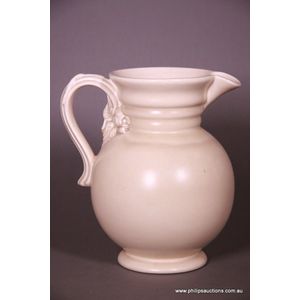Rare Xing Yao-type Ewer with Creamy-White Glaze
You must be a subscriber, and be logged in to view price and dealer details.
Subscribe Now to view actual auction price for this item
When you subscribe, you have the option of setting the currency in which to display prices to $Au, $US, $NZ or Stg.
- Ewer / Pitcher - A type of jug with a narrow neck bulbous body and wide spout, originally used for carrying and storing liquids such as water or wine. In medieval times they were the source of water to wash ones hands during and after a meal. later the shape was used for vessels in silver, gold, glass and ceramics.
In Victorian times they were made in ceramics and occasionally glass with a matching basin, and sometimes other accessories such as a soap holder or toothbrush holder. Their purpose was to provide facilities for personal washing In the early 19th century were often enclosed in purpose built stands, and later resided on a washstand..
Sometimes the words "ewer" and "pitcher" are used interchangably, but a pitcher is generally considered to be a jug, and would have a wide mouth, and a gently tapering body.
This item has been included into following indexes:
Visually similar items

A satin glazed pottery jug by Clarice Cliff, circa 1930s, pattern 895, the ovoid jug with a ribbed flaring neck, having a moulded flower and stem 'C' shaped handle, in an oatmeal coloured glaze; with raised signature mark underside and pattern number. Heig

Large Wedgwood 'Keith Murray' two handled vase

A fine full size Wedgwood Portland vase, Undraped Version. 1902, released as one of a limited range of prestige items from the 'Classical collection', in rich teal green solid jasper, depicting a continuous figural classical scene in white relief, the base

A Qingbai gourd-shaped ewer, song Dynasty, 12th century, with a large looped strap handle and long curved spout, an incised stylised motif at the base of each one and a triple stylised wave band around the shoulder, covered in a pale blue glaze, the flat b
